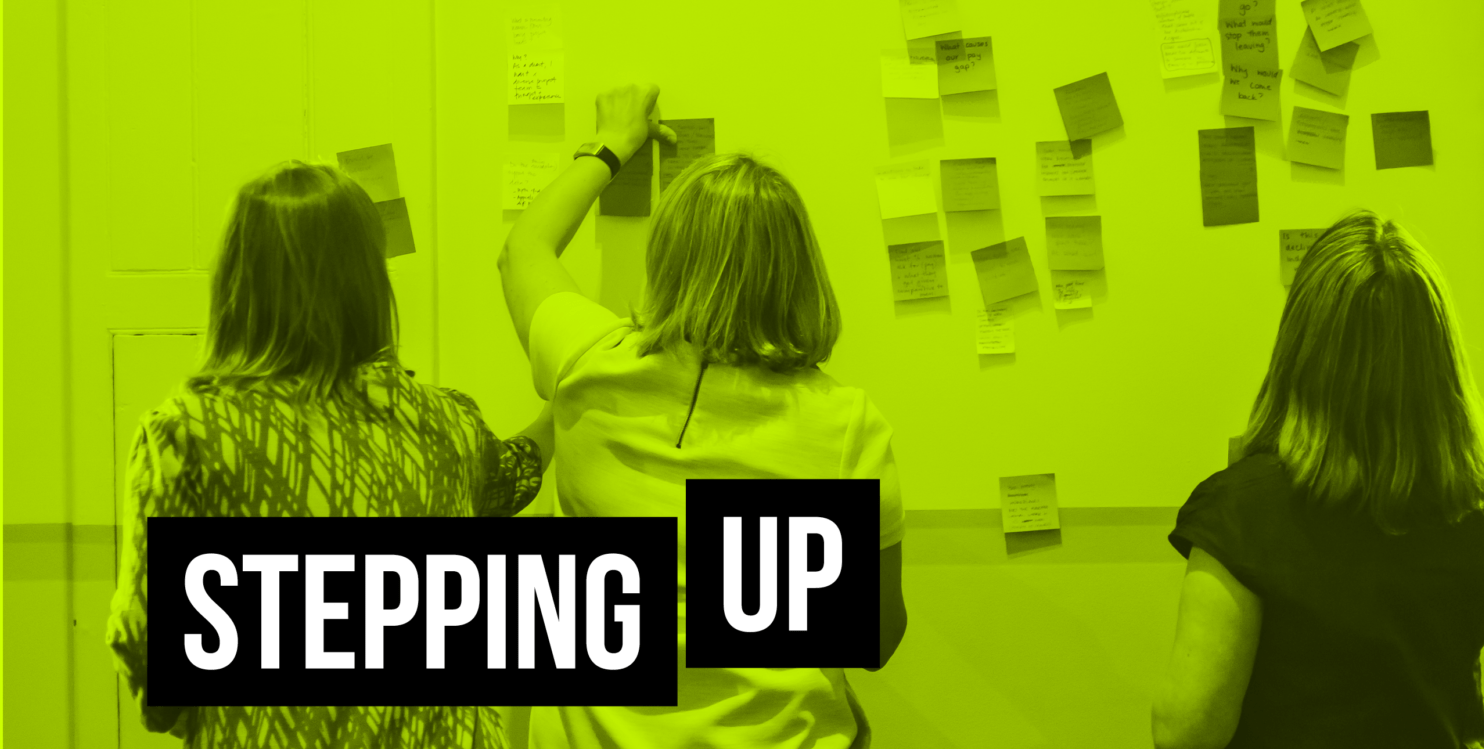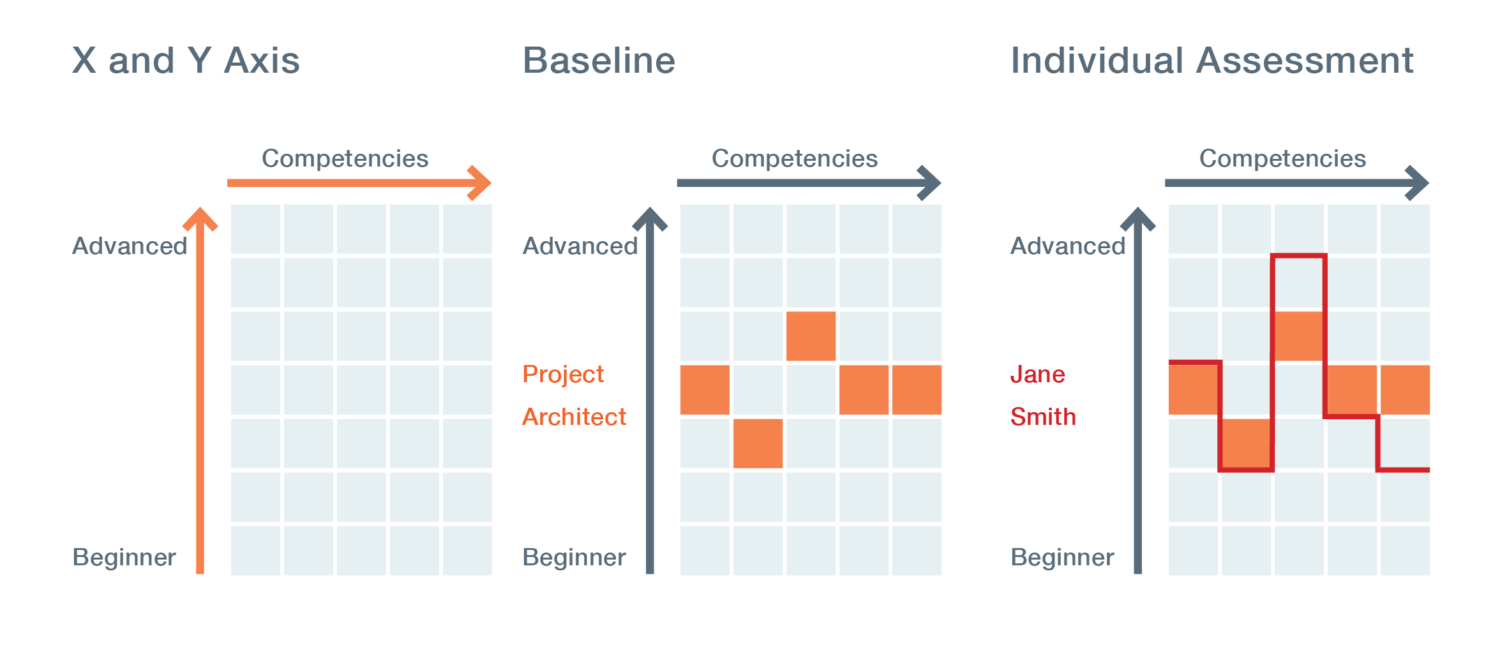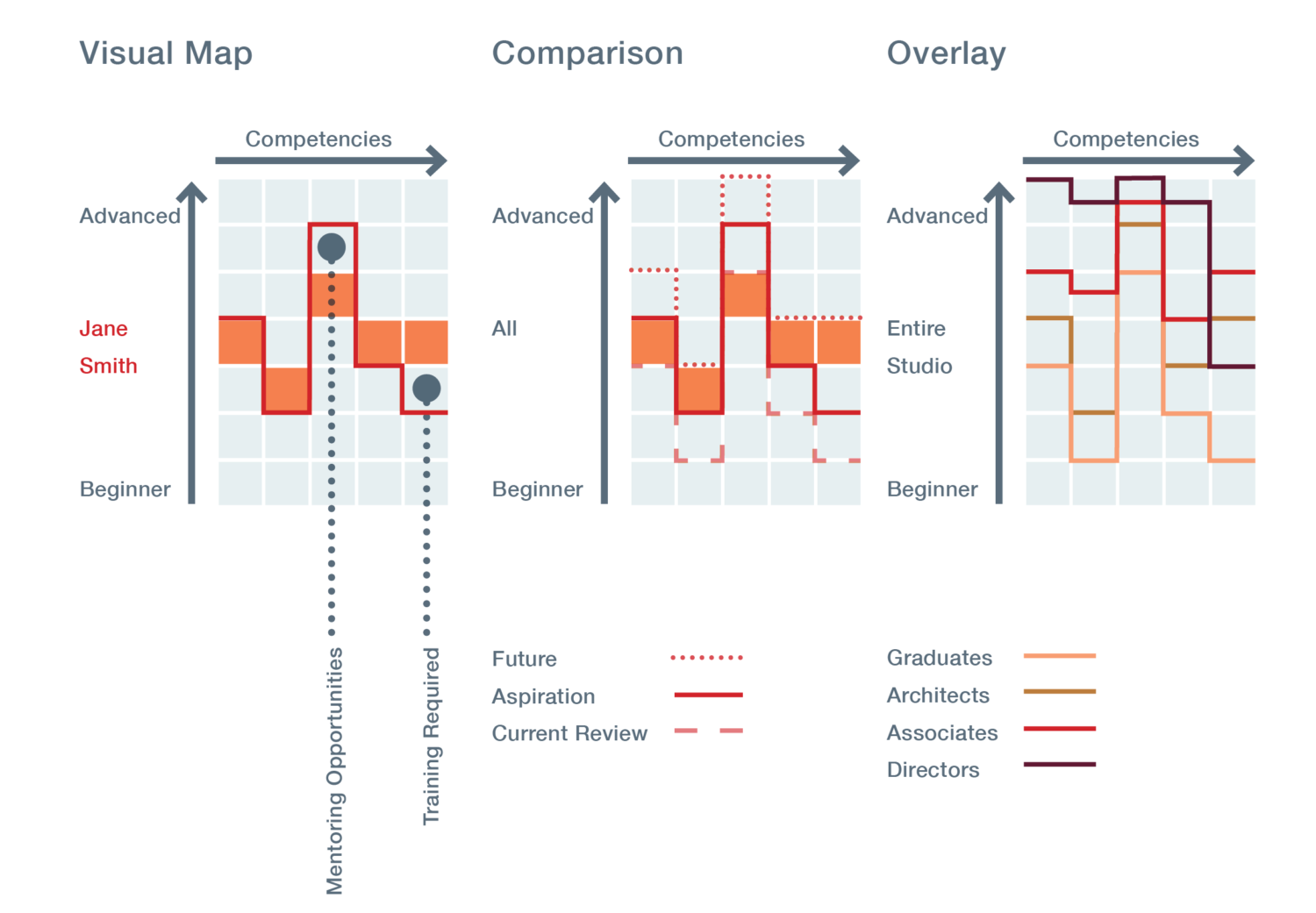Clarity and transparency are fundamental to equitable career planning and progression within practices, and yet processes are too-often unknown, opaque or entirely absent.
The Champions of Change Architecture Group has developed the Role Descriptions Tool and Competency Map to support architectural practices in developing a transparent system of career development within practices. This creates a clear visual guide of many skills required in our industry and the expected competencies for various career stages.

Without the right framework, we may limit or omit critical skills that could be an asset to the advancement of an architectural practice and the architecture industry as a whole.
Research in Champions of Change architecture practices uncovered an overwhelming lack of transparency in terms of why people are offered career advancement in these workplaces. At the core was a lack of communication about the expected levels of competency for various career stages.
In response, the Champions action group developed a Role Descriptions Toolkit. This includes a role descriptions framework and a customisable competency map, which offers a visual guide to describe technical, business and soft skills. The map can be used to create role descriptions, to map equitable career advancement, and to identify areas for personal and professional development and aspiration. Competency levels can then be determined by business needs and can be used to map the whole practice’s capability to inform recruitment as well as training and mentoring programs.
This article has four key sections.
Competency Map Principles
The Competency Map is grounded in the understanding that clear and defined roles are an essential part of supporting career progression within practices. A graphic representation of these roles allows for a clear map of an individual’s competencies and a pathway for progression. The core aspects of the map are as follows:

Axes
The Competency Map is organised by two key axes.
The first documents the set of competencies – this set can expand or contract to suit the size and culture of the practice.
The second provides the assessment range, typically from beginner to advanced.
Baseline
Coloured boxes create a visual map of the baseline for each role. They indicate an expected range of skills and the level a staff member should be performing at for a given role.
This is not necessarily a direct line; the shape and banding is more informative.
Individual assessment
An individual staff member’s performance is documented through a line overlaid on the baseline. This shows relative performance against the baseline.
The shape of the line in relation to the baseline is most informative, not the individual assessment.

Visual map
The visual comparison offers a clear map of an individual’s performance as plotted against the baseline.
This may reveal areas where training is required. It can also help identify suitable mentors in key areas and opportunities for promotion.
Comparison over time
Comparing a current assessment with mapping from earlier reviews can show how an individual has developed.
Plotting an agreed future line as part of a performance review process can help forecast future progression, and identify areas of growth and ambition.
Overlay
Overlaying several maps may be a useful tool for resourcing, proposing teams and job sharing potentials. It might also reveal training required or mentoring opportunities.
Overlaying the entire practice will reveal the practice profile and highlight any future needs for skills, which may be met through additional hiring or specific training beneficial to the practice.
Setting up and using the Competency Map
This section outlines how to set up sections of the Competency Map in detail, and how to map the baseline and conduct individual assessments.
Range of competencies & assessment system
The X axis of the Competency Map outlines the range of competencies, showing a core area, a description and a set of skills.

Core area
Core areas define those competencies that are most important to the practice.
Depending on the size of the studio, competencies may stand alone or several may be combined together.
Description
The description of the competency provides further information. It summarises the key attributes, providing clarity as to what the area encompasses.
Skills
The set of skills provides fine grain detail to allow assessment of an individual to be given against a defined list of skills.
The Y axis of the Competency Map provides the assessment system, showing performance in relation to each competency.

Range
The assessment system ranges from beginner to advanced and is divided into bands.
Guide
A descriptive guide for each band enables individuals to assess their performance against each competency.
Examples of guides
Exemplary record and skills – considered an industry leader
Exceptional record and skills – considered a studio leader
Excellent record and skills – considered a team leader
Demonstrates a proven record – has shown a continued development of skills over time
Demonstrates an interest – has capacity to develop under supervision and to contribute
Using the map – baselines & individual assessment
The baseline creates a visual map that indicates expectations for each role level within the studio.

Shape of the map
The shape of the map will vary for each role level and is defined by the expectations of the studio.
Each skill may have different weighting, depending on the culture of the studio.
Creating the baseline
The baseline may be formed by the average of a survey of all staff, or from a working group who determine the expectations of the studio.
The baseline will be relative to the assessment scale; however, each individual will be assessed compared to the baseline for their role only.
Range of Baseline
Some core areas or skills may require a broader range, rather than a single band. For example, a range might be particularly relevant for software skills.
An individual assessment is mapped over the baseline, creating a visual comparison that highlights the individual’s performance in relation to the baseline for their role level.

Shape of the line
The shape of the line indicates the performance of an individual at the time of the review.
The line can be formed by an average of self assessment and 360 degree peer reviews, or the practice may wish to plot all lines individually.
Several lines can be plotted; for example, the past review, the current review and the desired future goals.
Visual map
A map clearly shows where the individual is excelling, compared to the baseline of their role. It also highlights where further development may be required and a personal action plan can be agreed upon.
The map can clearly show how an individual may have progressed from the previous review and where they aspire to be in the future.
Comments
A comments section is a valuable way to capture specific observations about the individual’s performance or skills.
Implementing a Role Descriptions Framework
The day-to-day operations of an architecture practice require a mix of skillsets – ‘soft’ skills are essential and need to be refined along with spatial design, technical and graphic communication skills. Clear role descriptions are important to ensure that these ’soft‘ skills are valued within a practice. An architectural practice can be described as a system of roles – clearly articulating this enables individuals to plan and progress their careers.
The following guide provides tools to assess and develop a role descriptions framework to specifically relate to the culture, values and size of your practice.
1. Consider the skills and competencies required
The first step in assessing a practice’s current process and implementing a framework is to consider the skills and competencies required.
It is essential to consider ‘soft’ skills as well as the technical skills that are an inherent requirement for architects and are outlined in the current professional competency standards. Additional skills might include: leadership, communication and collaboration, people and team management, business management, commercial acumen, financial management, strategic thinking, business development, marketing and so on.
2. Customise your Competency Map
3. Develop a Role Descriptions Framework
Considerations for practices
The Competency Map is a useful starting point to help practices rethink how roles are defined and measured. Each practice is unique – the following prompts will help practices tailor meaningful, specific solutions.
Practice culture
Each architectural practice is different. Taking the time to identify and understand your culture is an important part of customising the map to suit your practice.
Evaluating performance
The assessment of individuals should be transparent and clear. Consider types of performance evaluation methods and how the practice’s own version of the map may describe and measure competencies.
Eliminating bias in recruitment and selection
Bias comes in many forms. Standardising the process of recruitment will help minimise any hiring prejudices.
Eliminating bias when evaluating employee performance
We all have biases, whether conscious or unconscious, and these can impact decisions around recruitment, talent development, career progression and promotion. Understand common biases and have strategies to eliminate these from the process.
Confirmation bias
This is when we seek to confirm our beliefs, ignoring contradictory evidence.
Group-think bias
This is a tendency to agree with the majority or someone more senior in order to maintain harmony.
Recency bias
This involves a focus on recent performance at the expense of more thorough assessment.
Halo effect bias
This involves allowing one good/bad trait to overshadow others.
Leniency bias
This involves giving favourable scores even though improvement needs to be made.
Idiosyncratic evaluation bias
This is when managers evaluate skills they are not good at and rate others more highly.
Affinity or mirror bias
This is the tendency to rate people more highly when they have similar likes/skillset. It results in homogeneous teams.
Gender bias
The tendency to favour one gender over another.
Flexibility bias
The tendency to make assumptions based on the hours staff work, or their personal situation.
Further uses
This framework provides the starting point for career planning and progression that assists individuals and the practice overall. It can inform a practice in a range of areas, including recruitment, resourcing, the review process, personal action plans, training, mentoring, promotions, practice gap analysis and practice profile.
Overlaying maps
Overlaying several maps may be a useful way to see the skills across a particular role, revealing if and where overall training is required. It may also indicate the need to hire in a particular specialist area to complement current staff skills.
Overlaying the maps of a proposed team or job sharing role might indicate if you have the balance of skills to best suit the project.
A visual practice profile
Overlaying the entire practice will reveal your practice profile and assist with a skills gap analysis. This will also highlight any future needs for skills, which could be addressed by hiring, or by arranging specific training that may be beneficial to a particular role level or the practice in general.
Future opportunities are made evident and a visual profile is created.
Mentoring opportunities
The map provides a visual guide as to where individuals are excelling at a particular skillset. This clearly indicates mentoring opportunities. Conversely, the map will indicate if an individual needs further development in an area. Matching these individuals together provides a strong base for a mentoring relationship.
For more information on career development, watch the recording of the On Career Development discussions, part 1 and 2.
This article was compiled by Justine Clark as part of a set that draws on the Role Descriptions toolkit, created by the Champions of Change Architecture Group.
Contributors to the toolkit include David Randerson (DKO), Brett Hudson (Peddle Thorp), Thihoa Gill (Grimshaw), Soo-Ling Kang (Grimshaw), Eeshenn Wong (Hayball), Tara Keast (DesignInc), Sofie Pringle (Peddle Thorp), Gemma MacDonald (DKO), Rebecca Champney (Nettleton Tribe), Will Nguyen (Grimshaw) and Amy Dowse (Tzannes).




















